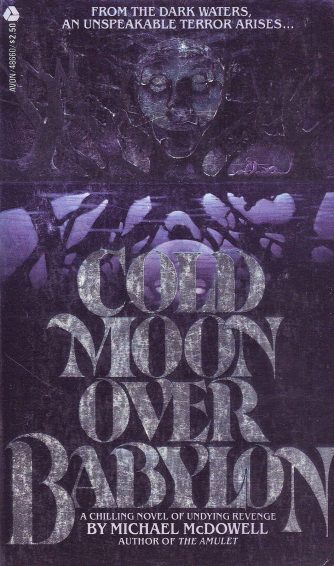 By MICHAEL McDOWELL (Avon; 1980)
By MICHAEL McDOWELL (Avon; 1980)
The late Michael McDowell never wrote a scarier novel than COLD MOON OVER BABYLON, a neglected classic of atmospheric horror. It was McDowell’s second novel, and admittedly takes some time to get up to speed, laying out its backwoods setting and characters with a great deal of expansiveness (McDowell claimed he was asked to double the length of his first novel THE AMULET prior to publication, which might also have been the case here). Yet McDowell’s descriptive power and storytelling prowess assure that the novel is never less than compulsively readable.
…McDowell’s descriptive power and storytelling prowess assure that the novel is never less than compulsively readable.
The place is the Florida town of Babylon, where the Larkins, a farming family scarred by tragedy, reside. Back in 1965 Jim and JoAnn Larkin were killed in a horrific incident while boating on the Styx River near their home, leaving behind Jim’s mother Evelyn and their two children Margaret and Jerry. The family is whittled down ever further when fifteen years later Margaret Larkin is brutally killed on the bridge over the Styx, and her corpse submerged in the water.
McDowell reveals the identity of the murderer early on: it’s Nathan Redfield, the son of a wealthy banker. Nathan, we learn, had callously impregnated the underage Margaret, and killed her so he wouldn’t have to face up to his responsibilities. There’s also the fact that he and his father are seeking to buy up the Larkins’ farm, and to facilitate this Nathan kills the remaining Larkins—and none too soon, as Evelyn believed he was behind Margaret’s killing, and wasn’t shy about voicing her suspicions. By this time, however, weird things have been occurring in Babylon: the waters of the Styx have grown strangely agitated and a spectral woman is seen in a tree where Nathan is canoodling with a lady friend.
McDowell reveals the identity of the murderer early on…
The odd happenings, which always occur in Nathan’s presence, steadily increase, leading up to a veritable joyride of supernatural mayhem that’s both teasingly eerie and quite gory. There’s nothing “suggestive” here, nor anything of the “it was so terrible I can’t describe it” variety, just a great deal of the type of robust descriptive power at which McDowell excelled.
Obviously the unquiet spirits of the Larkins are looking to take Nathan down (as revealed in the back cover description, which gives away the entire story), and drive him mad in the process. This essentially makes the severely unpleasant Nathan the protagonist of the book’s second half, which is unfortunate. However, it’s a testament to McDowell’s talent for characterization that Nathan never comes off as a one-dimensional bad guy. Rather, he’s just a severely flawed loser.
Integral to the book’s power is its rural southern setting, which is evoked with a great deal of chilly atmosphere. McDowell was admittedly quite influenced by classical Japanese horror, as exemplified by stories like those found in Lafcadio Hearn’s KWAIDAN and films like KURONEKO, wherein ghostly retribution was a popular theme. In COLD MOON OVER BABYLON McDowell transposed that theme and sensibility to the American south in a manner so seamless it’s a wonder no one else has ever tried it.
